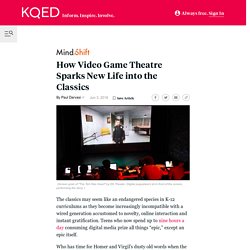

Keane Eyes Gallery. Why the Word Chibi Is So Offensive and Cute. Chibi.

The word probably brings a very specific image to your mind. Cute characters with big heads, small bodies, and wide eyes. (180) WALL-E Official Trailer (2008) Why Exactly Were Furbies Such Childhood Nightmare Fuel? Furby toys ‘turn nasty, seedy and inappropriate’ IT was one of the most coveted gifts of the festive period and turned up under thousands of Christmas trees last year.

Saturday, 8th February 2014, 11:39 am But now parents have hit out at popular must-have toy the Furby Boom after it emerged that some of the creatures have developed “inappropriate” second personalities which have upset their children. The Furby, an electronic robotic toy which requires children to talk to and stroke it, as well as feed and put it to sleep, was a major hit when makers Hasbro relaunched the 1990s classic last year. The cute creation made it into the toy hit lists for Christmas 2013.
Sign up to our daily newsletter. Game Design with Impact: The Psychology of Game Immersion. What do we mean when we call a game 'immersive'? How do you know you are immersed in a game?

There are lots of obvious signifiers: time passes unnoticed; you become unaware of events or people around you; your heart rate quickens in scary or exciting sections; you empathise with the characters... Basic stuff. But while we can reel off the symptoms, what are the causes? Do video-games have a relationship to theatre? : truegaming. Video Games As Extensions Of Theatre. In Somewhere, players set out for Kayamgadh, a mythical city of storytellers in colonial India.

In order to navigate through this city, a gamer takes on the avatar of a treasure hunter, detective or ghostbuster. The brainchild of game designers Dhruv Jani and Sushant Chakraborty Somewhere is a text-driven, interactive fiction video game. We tried three games at an event held by India Foundation for The Arts (IFA) at Voxelscapes, Koramangala. (164) VR Immersive Theater in The Under Presents: Tempest! (164) Playable Theatre: Game Design for Immersive Performance - Celia Pearce, Northeastern University. How Video Game Theatre Sparks New Life into the Classics. Experiencing a classical myth expressed as a video game resonated with the youthful audience, underscoring the value of articulating the past in a relevant and contemporary format, according to Kim.

“[Students] did not seem interested in us, in what we were doing, or in Ovid," he said. As the story unfolded, the audience became more interested. Thoughts on Theatre: Theatre vs. Video Games. To some of my students, there is an obvious problem with learning about theatre: theatre is boring but video games are cool!

When a person is playing a first person sci-fi action shoot ’em up game, it does seem hard to try and convince them that Shakespeare is even better… Since you can’t just change minds or people’s taste, let’s emphasize the similarities between theatre and video games. There are 3 simple ones to begin with, though there are certainly more if we think about it. First, in a video game you usually have a character or avatar that you control, and this is similar to an actor playing a role. The immersed audience: how theatre is taking its cue from video games. Under the arches of London Bridge two policemen pursue a murder suspect.

The man gasps for breath, desperately searching for an escape route as the cops close in. Meanwhile, some place not far away, a crowbar-wielding physicist lunges desperately at a reanimated corpse. Keane Eyes Gallery. CABINET / Our Aesthetic Categories: An Interview with Sianne Ngai. Our Aesthetic Categories on JSTOR. The Serious Subtext of Japan's "Cute" Culture. Anyone living in an urban area knows well that ever-present construction sites can be a nuisance (and sometimes, a danger).

Tokyo has thought of a way to make the sites a bit more appealing and, Japan being Japan, the answer is cute: cartoon road signs. Hello Kitty figures hang off bars to warn people away from holes, while elephants and dolphins decorate road barriers. This is all part of the culture of kawaii, or “cute,” that brought us Pikachu and Sanrio. The rest of the world has long been fascinated by kawaii, writes researcher Christine Yano in an article for the Journal of Asian Studies. There’s a Sanrio (which brought us Hello Kitty) in Times Square, while the MAC brand of makeup has a Hello Kitty line. The widespread Japanese embrace of cute has always been self-aware and political, according to Yano. The aggressive development of this aesthetic was not fully organic, but in fact developed with a “global wink,” as part of Japan’s plan to build cultural cachet overseas.
Williams Structures of feeling. (2) Cultural Materialism: WTF? Raymond Williams, Culture and Structures of Feeling. Four years later, how do you feel about Gamergate and its communities? : truegaming. To Cite or to Steal? When a Scholarly Project Turns Up in a Gallery. It’s early enough in my career that I still get a thrill whenever I see my work shared online.

As a scholar who works in both film studies and digital humanities, I use public domain scientific image analysis software to create “sums” of films, adding together the frames of a film to make one single abstract image. Since 2013, I have shared hundreds of these on Tumblr, Twitter, and Flickr, and written about my process in both popular and scholarly venues. Eva Illouz. Eva Illouz Illouz, in 2008.

Eva Illouz (Arabic: إيفا اللوز ; Hebrew: אווה אילוז) (born April 30, 1961 in Fes, Morocco) is a professor of Sociology at the Hebrew University in Jerusalem and the School for Advanced Studies in the Social Sciences in Paris. She was the first woman president of Bezalel Academy of Art and Design. Biography[edit] Eva Illouz was born in Fes, Morocco, and moved to France at the age of ten.[1] She received a bachelor's degree in Sociology, Communication and Literature in Paris, a master's degree in Literature at Paris X and a master's degree in Communication from the Hebrew University.[2] From 1986 until 1991 she studied Communications and Cultural Studies at the Annenberg School for Communication at the University of Pennsylvania in Philadelphia, where she received her PhD.
Academic career[edit] She taught at Tel Aviv University until 2000. The Irresistible Fairy Tale: The Cultural and Social History of a Genre on JSTOR. "Some Day My Prince Will Come": Female Acculturation through the Fairy Tale on JSTOR. Innovation in Art, Music, Sports, and Culture. Polar: Document Repository. The Last of Us 2 epitomizes one of gaming’s longest debates. TheThe Last of Us Part 2 punctuates one of the longest, strangest debates in video games: the 13-year discussion of ludonarrative dissonance. The term references the disconnect between what players do in a video game (ludo is Latin for “play”) and the story that the game tells (narrative). People were discussing this idea under different terms long before the phrase exploded in 2007, in part due to an oft-cited blog post by game designer Clint Hocking that used the phrase.
After that, big-budget video games collectively calcified around its central dilemma.
Women in Gaming. Instafamous: Meet the social media influencers redefining celebrity. 'Celebrity' is diversifying. Where once only film stars, singers or high-end fashion models represented by powerful agencies would fit under this classification, social media influencers are now working their way to the fore. Instead of turning to the pages of magazines, catwalks or films, Generations Y and Z now look to Instagram, Facebook and Twitter in search of their idols.
These idols are the models, bloggers, trainers and influencers who have become recognised names - at least online – initially without agents, simply by attracting huge followings on their social media accounts. They now form the new ‘It’ crowd with their cult followings, steering trends, setting agendas and often commanding thousands for posts apparently showing just a snippet of their day. Download the new Independent Premium app. The Last of Us 2 outdoes the first game’s giraffe scene. Polar: Document Repository. How did virtual reality begin? - Virtual Reality Society. This is a popular question: how did virtual reality begin which is often accompanied by who invented it and/or came up with the term virtual reality.
The issue of who coined the term virtual reality as well as who invented virtual reality is discussed as two separate articles. This articles looks at where it all began. Virtual reality is considered to have begun in the 1950’s but early elements of it can be traced back to the 1860’s and long before the development of digital technology. Early artistic examples of virtual reality An example of this is large, 360 degree murals which enabled the observer to engage with the artwork on a simple level. Early simulation device. What is virtual reality gaming? - Virtual Reality Society. Virtual reality gaming is where a person can experience being in a three-dimensional environment and interact with that environment during a game. Micro - NO. 24 (1980-05)(Micro Ink)(US) : Free Download, Borrow, and Streaming. BBC Radio 4 - The Digital Human. The Anxieties of Authenticity in Post 2000 British Fiction.
A Manner of Speaking: Language In The Digital Age.
I looked at this primarily as it dealt with my two passions; language and the digital and started me thinking about how the digital can affect language. – tsimms01
TED Global Talk 2013: Digital Culture, Language, Revolution. The Freudian Robot: Digital Media and the Future of the Unconscious - Lydia H. Liu. Creating identity in the digital world. Technology Makes Us Escapist; The Cult Of the Mind.
I thought that this would be a good starting place to research the idea that the evolution of technology could be becoming it by leaving our physical bodies behind – tsimms01